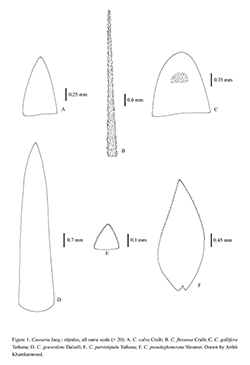e-Flora of Thailand
Volume 13 > Part 1 > Year 2015 > Page 23 > Salicaceae > Casearia
4. Casearia flexuosa Craibwfo-0000923959
Bull. Misc. Inform. Kew 1911: 54. 1911; Fl. Siam. 1: 735. 1931; Lescot, Fl. Cambodge, Laos & Vietnam 11: 48, pl. 5. 1970; Sleumer, Blumea 30: 245. 1985; Gardner et al., Forest Trees N Thailand 55. 2000 Q.E.Yang & Zmarzty, Fl. China 13: 134. 2007. Fig. 1B; Plate III: 1–2.
Accepted Name : This is currently accepted.
Synonyms & Citations :
Description : Shrub or treelet to 4 m; stems with persistent, relatively dense, patent hairs. Stipules often persistent, linear or lanceolate, to 7 mm long, hairy. Leaves with petiole to 1 cm, short hairs present; blade narrowly elliptic or narrowly obovate, to 15 by 5 cm, base mostly symmetric, cuneate, marginal teeth mostly persistent, apex acute to acuminate; up to 8 pairs of ascending lateral veins; both surfaces usually with patent hairs, denser on lower surface, rarely with hairs restricted to veins. Flower pedicels to 3 mm long, glabrous or with scattered hairs. Sepals narrowly elliptic, to 4 mm long, glabrous or with scattered hairs on both surfaces, margin short-ciliate. Stamens to 1 mm long, filaments hairy. Ovary with scattered hairs, dense at base of style. Fruit ellipsoid, to 1.5 by 1 cm.
Thailand : NORTHERN: Chiang Mai (Doi Suthep – type: Kerr 694, holotype -K, isotypes -BM P), Chiang Rai, Lampang, Phitsanulok; NORTH-EASTERN: Phetchabun, Loei, Nong Khai, Sakhon Nakhon, Nakhon Phanom, Khon Kaen; EASTERN: Chaiyaphum, Nakhon Ratchasima, Surin; CENTRAL: Saraburi; SOUTH-EASTERN: Chachoengsao, Chonburi.
Distribution : China, Vietnam, Laos.
Ecology : In dry evergreen and mixed deciduous forests, as well as other more open habitats.
Vernacular : Ma taek ton (มะแตกต้น)(Lampang).
Notes: In most Casearia species the teeth on the margin of the leaf fall off shortly after the leaf unfurls, but in C. flexuosa they often persist, even on older leaves. The stipules also more persistent than those of other Casearia species.


